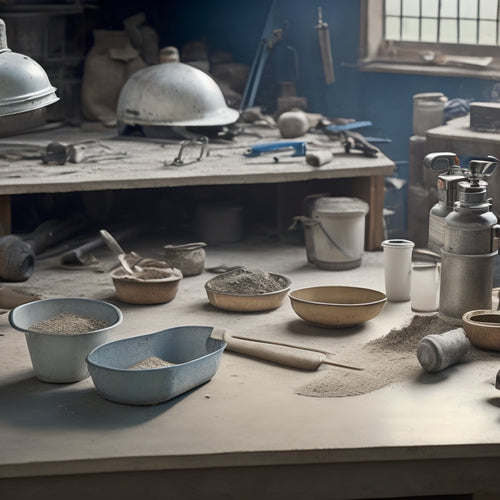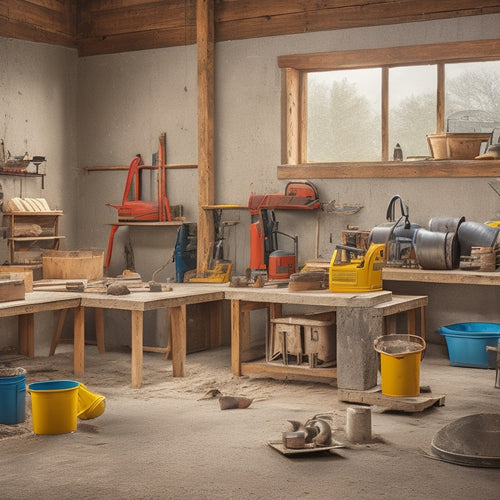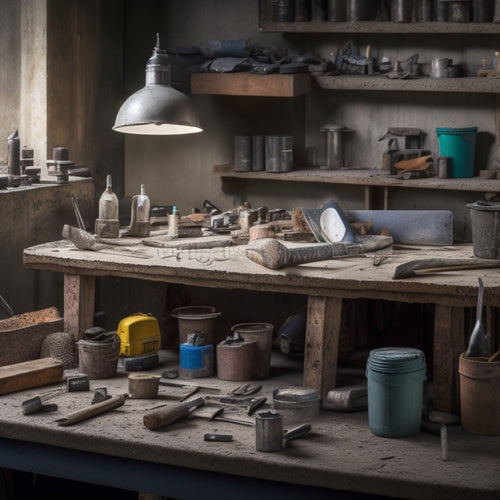
Essential Tools for Planting in Concrete Planters
Share
You'll need a sturdy trowel for scooping and transferring soil, a cultivator for breaking up clods and aerating, a watering can with small holes for targeted watering, and pruning shears for trimming and shaping plants. Don't forget to maintain your tools by cleaning and applying rust-inhibiting coatings after use. Select high-quality potting mix, compost, and fertilizer tailored to your plants' specific needs, and consider peat moss or coconut coir for moisture retention. With the right tools and materials, you're ready to create a thriving oasis - and there's more to explore to guarantee your concrete planter's success.
Key Takeaways
• Invest in a sturdy trowel for soil scooping and transferring in concrete planters.
• Use a cultivator to break up clods and aerate soil before planting in planters.
• Select a watering can with small holes for targeted watering to avoid waterlogged soil.
• Acquire pruning shears for trimming and shaping plants in concrete planters.
• Maintain tools by cleaning after use and applying rust-inhibiting coatings to extend their lifespan.
Choosing the Right Tools
When preparing to plant, you'll need to select a set of tools that can efficiently tackle various tasks, from soil preparation to plant care. A well-curated arsenal of tools will help you master different planting techniques, ensuring your plants thrive in their concrete planters.
Start by investing in a sturdy trowel for scooping and transferring soil, as well as a cultivator for breaking up clods and aerating the soil. Don't forget a watering can with small holes to deliver water directly to the roots, and pruning shears for trimming and shaping your plants.
Regular tool maintenance is vital to extend the lifespan of your tools and prevent rust. Clean your tools after each use, and store them in a dry place. Apply a rust-inhibiting coating to metal tools, and sharpen blades regularly to maintain their effectiveness.
Essential Materials for Preparation
As you prepare to plant, gather essential materials like high-quality potting mix, compost, and fertilizer to create a nutrient-rich soil blend that will support healthy plant growth.
The type of potting mix you choose will depend on the specific needs of your plants, as well as the soil types you're working with. For example, if you're planting succulents, you'll want a mix that drains excess water quickly.
Some key materials to evaluate include:
-
Peat moss or coconut coir: These help retain moisture and improve soil structure.
-
Composted bark or straw: These add organic matter and can help with drainage.
-
Balanced fertilizer: Look for a fertilizer with equal N-P-K ratios (e.g., 10-10-10) to provide a balanced diet for your plants.
When selecting fertilizer options, assess the specific needs of your plants. Are they heavy feeders or light feeders? Do they require more nitrogen, phosphorus, or potassium?
Efficient Soil Mixing Methods
You'll achieve ideal soil blending by adopting efficient mixing methods that guarantee uniform distribution of ingredients and minimize the risk of over- or under-mixing. This is vital, as it directly affects soil aeration techniques and best moisture retention. To ascertain the perfect blend, follow these guidelines:
| Mixing Method | Advantages | Tips |
|---|---|---|
| Double-Shovel Method | Guarantees uniform distribution, prevents over-mixing | Alternate shovels to mix, use gentle turns |
| Trowel-Folding Method | Preserves soil structure, prevents aeration loss | Fold soil gently, avoid compacting |
| Soil Sifter Method | Removes debris, guarantees best moisture retention | Sift in a circular motion, use a fine-mesh sieve |
When mixing, start by combining dry ingredients, then gradually add water while mixing. Avoid over-mixing, as it can damage soil structure and lead to poor drainage. By adopting these efficient soil mixing methods, you'll create an ideal growing environment for your plants in concrete planters.
Planting and Arrangement Tips
Proper planting and arrangement techniques release the full potential of your carefully crafted soil blend, guaranteeing a thriving display in your concrete planters. You've put in the effort to create a rich, well-draining soil mix; now it's time to showcase your plants.
When selecting plants, consider factors like sunlight, temperature, and moisture requirements to guarantee harmony among your chosen species. Balance contrasting textures, colors, and forms to create visual interest. For a cohesive look, group plants by theme, such as succulents or herbs.
Some essential arrangement techniques to keep in mind:
-
Create a focal point: Designate a statement piece, like a showy flower or striking foliage, to draw the eye.
-
Play with proportions: Combine large, medium, and small plants to add depth and visual appeal.
-
Leave space to breathe: Don't overcrowd your planter, allowing each plant room to grow and receive adequate air circulation.
Waterproofing and Drainage Solutions
To guarantee your concrete planters remain protected and your plants thrive, apply a waterproofing coating to the interior and exterior surfaces of the planter, then install a drainage system that prevents waterlogged soil. This essential step guarantees the planter's longevity and prevents damage from moisture accumulation.
When selecting a waterproofing technique, consider a silicone-based or polyurethane-based coating, which provides a durable barrier against water penetration. For peak drainage, install a system that allows excess water to escape while maintaining soil moisture. You can achieve this by drilling holes in the bottom of the planter or incorporating a built-in drainage tray.
When designing your drainage system, consider the type of plants you're using and their watering needs. For plants that require frequent watering, a more extensive drainage system may be necessary. Conversely, plants that prefer drier soil may require a more limited drainage system.
Frequently Asked Questions
How Often Should I Water Plants in Concrete Planters?
When you're planting in concrete, you'll need to fine-tune your watering frequency.
Since concrete absorbs moisture, you'll want to check the soil daily, especially during hot or dry spells.
You're aiming for a balance: the soil should feel damp, but not waterlogged.
As a rule of thumb, water every 2-3 days in summer, and every 4-5 days in spring and fall.
Adjust according to your climate and the plant's moisture retention needs.
Can I Use Concrete Planters in Extreme Weather Conditions?
You're probably thinking, 'Won't concrete planters crack under the scorching sun or shatter in freezing temps?'
Yes, extreme temperatures can be a challenge.
But, with proper preparation, you can use concrete planters in harsh weather conditions.
Make sure your planter has adequate drainage to prevent waterlogged soil, which can lead to drainage issues.
Also, apply a waterproof coating to protect the concrete from moisture damage.
With these precautions, your plants will thrive, even in the most unforgiving climates.
Are Concrete Planters Safe for Pets and Children?
When you bring concrete planters into your outdoor space, you're probably wondering if they're safe for your pets and kids. Rest assured, you're taking a responsible step.
Concrete planters are non-toxic and won't leach harmful chemicals, ensuring pet safety and child safety.
The rough texture can be a minor scratch hazard, but it's easily mitigated with a sealant or a cushioning mat.
With minimal precautions, you can enjoy your planters while keeping your loved ones protected.
Can I Paint or Stain My Concrete Planters?
You're wondering if you can give your concrete planters a personalized touch. Absolutely! You can paint or stain them to match your outdoor decor.
When it comes to painting, you'll want to use a concrete-specific primer and paint, and consider techniques like stenciling or ombre for a unique look.
For staining, choose from acid-based or water-based options, and think about the level of transparency you want to achieve.
With the right materials and a little creativity, you can transform your planters into one-of-a-kind masterpieces.
How Do I Move Heavy Concrete Planters Safely?
When you're faced with moving heavy concrete planters, you'll want to prioritize safety above all.
You'll need to master moving techniques that distribute the weight evenly, like the 'lift with your legs' method.
Invest in lifting equipment like dollies, straps, or pulleys to reduce strain.
You'll also want to clear the path of any obstacles and have a clear destination in mind.
Conclusion
As you put the finishing touches on your concrete planter masterpiece, remember that the right tools are the brushstrokes that bring your vision to life.
Like a conductor leading an orchestra, you've harmoniously blended preparation, mixing, and planting to create a symphony of textures and hues.
Now, stand back and admire your handiwork, knowing that with these essential tools, your concrete planter is a work of art that will flourish for seasons to come.
Related Posts
-

What Tools Do You Need for Concrete Success
For concrete success, you'll need a range of essential power tools, including rotary hammers, angle grinders, concret...
-

What Tools to Rent for a Concrete Home Reno
When tackling a concrete home renovation, you'll need to rent a variety of specialized tools to get the job done. For...
-

Top Tools for Concrete Repair Success
When it comes to concrete repair success, you'll need a well-stocked toolkit with essential hand tools like trowels, ...


